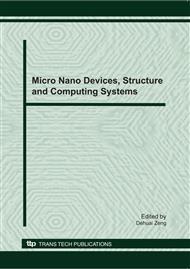[1]
Frank Yeong-Sung Lin , Hong-Hsu Yen and Shu-Ping Lin, A Novel Energy-Efficient MAC Aware Data Aggregation Routing in Wireless Sensor Networks, Sensors, 2009(9), 1518-1533.
DOI: 10.3390/s90301518
Google Scholar
[2]
Krishnamachari, B.; Estrin, D.; Wicker, S. Modeling Data-Centric Routing in Wireless Sensor , Networks. USC Computer Engineering Technical Report CENG 02-14, (2002).
Google Scholar
[3]
Qin Wang, WoodwardYang, Energy Consumption Model for Power Management in Wireless Sensor Networks,. IEEE Communications Society, 2007. pp.142-151.
Google Scholar
[4]
Heinzelman W, Chandrakasan A, Balakrishnan H. Energy efficient communication protocol for wireless microsensor networks Proceedings of the 33rd Annual Hawaill International Conferenc On System Sciences, Jan 4-7, 2000, Maui, HI, USA. Los Alamitos CA, USA: IEEE Computer Society, 2000: 223.
DOI: 10.1109/hicss.2000.926982
Google Scholar
[5]
Santi P,Simon J.Silence is Golden with Hi}gh Probability:Maintaining a Connected Backbone in Wireless Sensor Networks.In Proceeding of 1st European Workshop on WirelessSensor Networks(EWSN 2004),Jan 2004,106—121.
Google Scholar
[6]
Heinzelman W,chandrakasan A,BalakrishnanH.An Application-Specific Protocol Architecture for Wireless Microsensor Networks.IEEE Transactions on Wireless Communications,October 2002, 1(4):660—670.
DOI: 10.1109/twc.2002.804190
Google Scholar
[7]
Intanagonwiwat C, Govindan R, Estdn D,et a1.Directed Diffusion for Wireless Sensor Networking [J].IEEE/ACM Transactions on Networking,2003,1 1(1):2—16.
DOI: 10.1109/tnet.2002.808417
Google Scholar
[8]
Manjeshwar A,Agrawal D.TEEN:A Protocol for Enhanced Efficiency in Wireless Sensor Networks.In Proceeding of the lth International Workshop on Parallel and Distributed Computing Issues in Wireless Networks and Mobile Computing'01.2001:23-27.
DOI: 10.1109/ipdps.2001.925197
Google Scholar
[9]
Xinyun Fan, Fubao Wang etc, Wireless sensor network routing protocols. Computer Measurement & Control, 2005, 1 3 (9) : 1010-10139] Xinyun Fan, Fubao Wang etc, Wireless sensor network routing protocols. Computer Measurement & Control, 2005, 1 3 (9) : 1010-1013.
DOI: 10.1109/cmcsn.2012.22
Google Scholar
[10]
LindseyS, Raghavendra C.PEGASlS:Power-Efficient Gathering in Sensor Information Systems.In Proceeding of the IEEE Aerospace Conference.Montana:IEEE Aerospace and Electronic Systems Society,2002:1 125-l 130.
Google Scholar
[11]
Cullar D,Estrin D,Strvastava M.Overview ofSensor Network.Computer, 2004,37(8):41—49.
Google Scholar
[12]
Sinhua A,Chandrakasan A.Dynamic Power Management in Wireless Sensor Networks.IEEE Design and Test ofComputer, 2001,18(2):62—74.
Google Scholar
[13]
Karp Brad,Kung H.GPSR:Greedy Perimeter Stateless Routing for Wireless Networks.In Proceeding of the 6th Annual ACM/IEEE International Conference on Mobile Computing and Networking,Boston:ACM Press,2000,243—254.
DOI: 10.1145/345910.345953
Google Scholar
[14]
Shensheng Tang, Wei Li, QoS supporting and optimal energy allocation for a cluster based wireless sensor network. Computer Communications , pp: 2569–2577, 2006(29).
DOI: 10.1016/j.comcom.2006.02.007
Google Scholar
[15]
M. Younis, M. Youssef, K. Arisha, Energy-aware routing in cluster-based sensor networks, in: Proc. of the 10th IEEE/ACM Sym. onModeling, Analysis and Simulation of Computer and TelecomSystems (MASCOTS'02), Fort Worth, TX, October (2002).
DOI: 10.1109/mascot.2002.1167069
Google Scholar
[16]
W.R. Heinzelman, A. Chandrakasan, H. Balakrishnan, Energy-efficient communication protocol for wireless sensor networks, in Proc. of the 33rd Hawaii International Conference on System Sciences, Jan. (2000).
DOI: 10.1109/hicss.2000.926982
Google Scholar
[17]
Jain-Shing Liu , Chun-Hung Richard Lin, Energy-efficiency clustering protocol in wireless sensor networks. Ad Hoc Networks 3 (2005) 371–388.
DOI: 10.1016/j.adhoc.2003.09.012
Google Scholar
[18]
ESTRIN D. Tutorial wireless sensor networks part IV: Sensor Networks Protocols[R]. Mobicom, (2002).
Google Scholar


